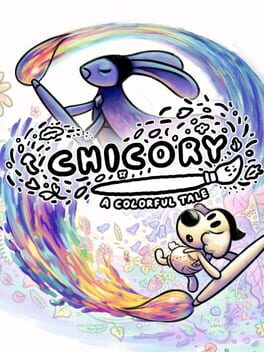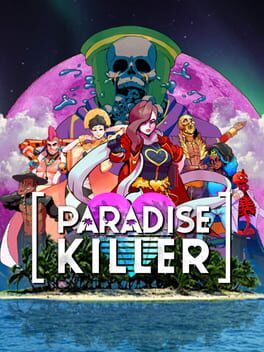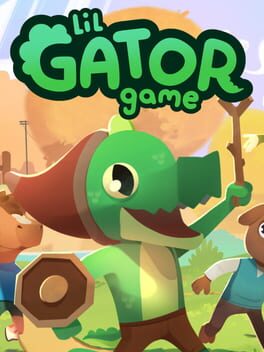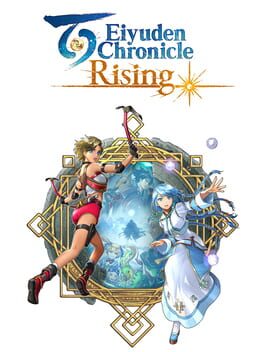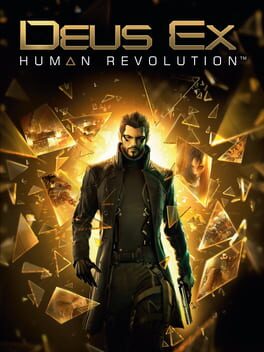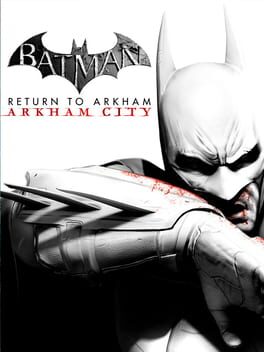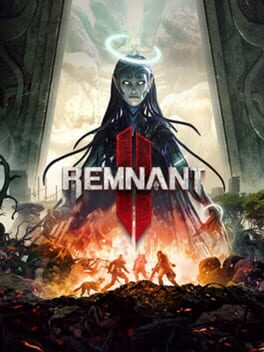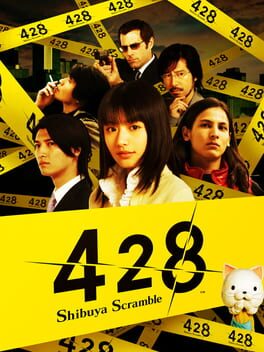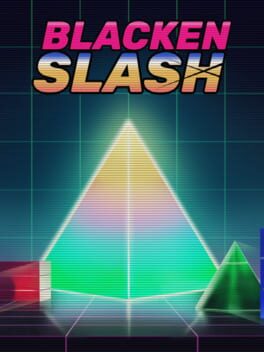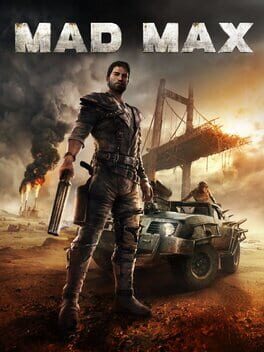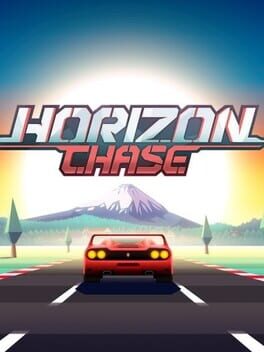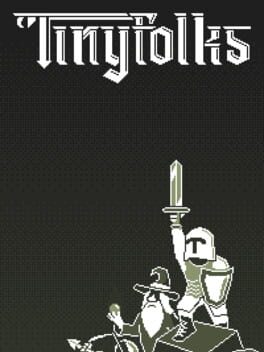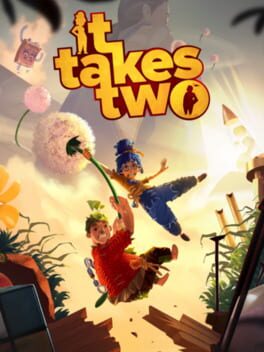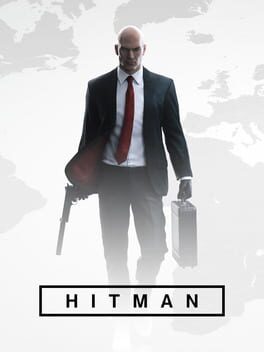toadhjo
Chicory tries to meld the coziness of Animal Crossing with the action and adventure of Zelda. There are towns to visit, characters to chat with, and portraits to paint; likewise, there are dungeons to delve through and bosses to battle. It sounds great, and in some ways it is, but unfortunately there are a few niggles that dampen the proceedings.
Let's start with the story and characters. The main characters are a highlight -- the dynamic between the protagonist and Chicory is one of the best parts of the game. Both characters have clear motivations and distinct personalities, and their conversations flow between topics like friendship, confidence, and artistry with ease. Reading their conversations is always a joy.
As for the other NPCs, my feelings are mixed. They're all fun and quirky, but I rarely felt engaged when chatting with them. They'd tell me about their problems, or thank me for painting their houses, or talk about what they'd had for lunch, and I'd simply nod my head and wonder how soon I could get back to the main crux of the adventure.
The adventure itself is also one of ups and downs. Exploring the map is fun, and the game offers up plenty of clever puzzles to solve, both mandatory and optional. If you've played a Zelda game, you can expect puzzles in that vein, although often with unique painting-centric twists.
The bosses, on the other hand, were frustrating. Because there are no Game Overs in Chicory, the bosses aren't difficult in the traditional sense, but they do take a lot of hits to bring down. Although the battles look intense, knowing you can't lose drains them of any sense of tension. Just keep swiping with your brush and you'll win eventually.
While I appreciate the story and I'm glad that Chicory exists, for me it feels a bit too at odds with itself. It has an abundance of cute characters but 90% of them have nothing interesting to say; it's a Zelda-like adventure but with boss battles that feel less tense and more tedious. The result is still a strong game, but one that could've been even stronger if it had cut a bit of fat and doubled down on what it does well.
Let's start with the story and characters. The main characters are a highlight -- the dynamic between the protagonist and Chicory is one of the best parts of the game. Both characters have clear motivations and distinct personalities, and their conversations flow between topics like friendship, confidence, and artistry with ease. Reading their conversations is always a joy.
As for the other NPCs, my feelings are mixed. They're all fun and quirky, but I rarely felt engaged when chatting with them. They'd tell me about their problems, or thank me for painting their houses, or talk about what they'd had for lunch, and I'd simply nod my head and wonder how soon I could get back to the main crux of the adventure.
The adventure itself is also one of ups and downs. Exploring the map is fun, and the game offers up plenty of clever puzzles to solve, both mandatory and optional. If you've played a Zelda game, you can expect puzzles in that vein, although often with unique painting-centric twists.
The bosses, on the other hand, were frustrating. Because there are no Game Overs in Chicory, the bosses aren't difficult in the traditional sense, but they do take a lot of hits to bring down. Although the battles look intense, knowing you can't lose drains them of any sense of tension. Just keep swiping with your brush and you'll win eventually.
While I appreciate the story and I'm glad that Chicory exists, for me it feels a bit too at odds with itself. It has an abundance of cute characters but 90% of them have nothing interesting to say; it's a Zelda-like adventure but with boss battles that feel less tense and more tedious. The result is still a strong game, but one that could've been even stronger if it had cut a bit of fat and doubled down on what it does well.
2020
Remember way way back, before Persona 5 and Dark Souls, when Atlus and From Software were making weird niche games that rarely left Japan and sold only like 10,000 copies? Because Paradise Killer will bring all those memories rushing back. It's a zany, colorful blast from the past that would feel right at home on Dreamcast.
Although it's often compared to Phoenix Wright, Paradise Killer has more in common with collectathon platformers. You spend most of your time running around Island 24, gathering clues, collecting blood vials, and interrogating suspects. It's a true open-world game -- there are only a few progress-blocking gates, and most of them can be worked around in multiple ways. You can also end the game at any point. Once you feel you've collected enough evidence, you can return to the judge and start the trial.
Being an open-world game, Paradise Killer exhibits the same pros and cons that are common in the genre. Early on, when the world was still full of collectibles, I had a lot of fun running around, jumping up mountains, and chatting with random characters. But as I neared the end and there were only a few unresolved mysteries and uncollected items left, my patience began to wane as I aimlessly ran around the map in search of the missing piece. Ultimately I was able to find everything without resorting to checking a guide, but not before feeling a twinge of boredom.
Naturally, the game's open-world nature impacts not only the gameplay, but the narrative as well. In my case, I stumbled upon a very big piece of evidence right at the end of the game -- it was literally the last thing I found before taking my case to trial. Because my playthrough unfolded the way it did, this revelation led to a serious sense of deus ex machina. It was like the final piece clicking into place and it felt all too convenient. If I'd found it earlier and had been given time to mentally fit it into my investigative puzzle, perhaps it wouldn't have felt like such an abrupt contrivance. I suppose that's just the nature of open-world games. Everyone's experience will be a bit different, for better or worse.
The final trial is also relatively straightforward. If you're expecting the twists and turns of an Ace Attorney game, you'll be disappointed. Despite that, however, the character are well written and the story that's here is enjoyable enough.
Finally, I must note that the soundtrack is an absolute banger. If anything, I think it's underutilized -- the songs are played as background music when they really deserve more time in the spotlight.
Anyhow, that's Paradise Killer in a nutshell. Come for the platforming and vaporwave vibes, stay for the characters. I'll see you in Perfect 25.
Although it's often compared to Phoenix Wright, Paradise Killer has more in common with collectathon platformers. You spend most of your time running around Island 24, gathering clues, collecting blood vials, and interrogating suspects. It's a true open-world game -- there are only a few progress-blocking gates, and most of them can be worked around in multiple ways. You can also end the game at any point. Once you feel you've collected enough evidence, you can return to the judge and start the trial.
Being an open-world game, Paradise Killer exhibits the same pros and cons that are common in the genre. Early on, when the world was still full of collectibles, I had a lot of fun running around, jumping up mountains, and chatting with random characters. But as I neared the end and there were only a few unresolved mysteries and uncollected items left, my patience began to wane as I aimlessly ran around the map in search of the missing piece. Ultimately I was able to find everything without resorting to checking a guide, but not before feeling a twinge of boredom.
Naturally, the game's open-world nature impacts not only the gameplay, but the narrative as well. In my case, I stumbled upon a very big piece of evidence right at the end of the game -- it was literally the last thing I found before taking my case to trial. Because my playthrough unfolded the way it did, this revelation led to a serious sense of deus ex machina. It was like the final piece clicking into place and it felt all too convenient. If I'd found it earlier and had been given time to mentally fit it into my investigative puzzle, perhaps it wouldn't have felt like such an abrupt contrivance. I suppose that's just the nature of open-world games. Everyone's experience will be a bit different, for better or worse.
The final trial is also relatively straightforward. If you're expecting the twists and turns of an Ace Attorney game, you'll be disappointed. Despite that, however, the character are well written and the story that's here is enjoyable enough.
Finally, I must note that the soundtrack is an absolute banger. If anything, I think it's underutilized -- the songs are played as background music when they really deserve more time in the spotlight.
Anyhow, that's Paradise Killer in a nutshell. Come for the platforming and vaporwave vibes, stay for the characters. I'll see you in Perfect 25.
2022
A Short Hike + Sword = Lil Gator Game
That's basically what this one comes down to. What's interesting to me is that I definitely enjoyed this more than A Short Hike. Why? It all comes down to expectations.
By the time I got around to playing A Short Hike, it was already a bonafide indie darling -- one that, judging from its review scores, could be considered one of the greatest indie games of all time. So when I played it and found that it was just a short, pleasant (albeit well-executed) platformer, I couldn't help but feel a bit disappointed.
Before playing Lil Gator Game, on the other hand, I had zero expectations. And because of this it was a lot easier for me to just accept it for what it is -- a pleasant, short game inspired by A Short Hike, Wind Waker, and Breath of the Wild.
Running around an island and slashing cardboard enemies is mindless, yes, but not every game needs to be Battletoads or Mega Man 2. The writing is a bit too self-aware and the story didn't hit me in the feels like I suspect it hoped to, but the gameplay was engaging enough to keep me invested until the end. Is it a masterpiece? Not by any means. But if you subscribe to Game Pass and three hours to kill, you could do a lot worse than spending them on this game.
That's basically what this one comes down to. What's interesting to me is that I definitely enjoyed this more than A Short Hike. Why? It all comes down to expectations.
By the time I got around to playing A Short Hike, it was already a bonafide indie darling -- one that, judging from its review scores, could be considered one of the greatest indie games of all time. So when I played it and found that it was just a short, pleasant (albeit well-executed) platformer, I couldn't help but feel a bit disappointed.
Before playing Lil Gator Game, on the other hand, I had zero expectations. And because of this it was a lot easier for me to just accept it for what it is -- a pleasant, short game inspired by A Short Hike, Wind Waker, and Breath of the Wild.
Running around an island and slashing cardboard enemies is mindless, yes, but not every game needs to be Battletoads or Mega Man 2. The writing is a bit too self-aware and the story didn't hit me in the feels like I suspect it hoped to, but the gameplay was engaging enough to keep me invested until the end. Is it a masterpiece? Not by any means. But if you subscribe to Game Pass and three hours to kill, you could do a lot worse than spending them on this game.
Eiyuden Chronicle Rising is a game propelled by charm. Charming characters, charming artwork, a charming soundtrack -- one I often found myself humming along to. On the surface, it does a lot right. Dig beyond the topsoil, though, and all you'll find is an idle clicker RPG with an action game bolted onto it.
In fairness, the game does seem to be aware of its own mundanity. You spend most of your time completing fetch quests for villagers, who give you worthless stamps in return, and the main character, CJ, absolutely loves collecting stamps. In a way it almost feels like the developers are calling me out -- like CJ, I'm completing in-game tasks merely for the sake of completing tasks. Next round of gold stars is on me!
The action-based combat is fairly simple, but it's not all bad. The midgame, from about the 2-hour mark to the 6-hour mark, is a high point, as you gradually gain new abilities and integrate new characters into your party. But by the time the game is only at the halfway mark it completely stops evolving. The steady drip of new mechanics dries up, leaving you with little to look forward to besides elemental re-skins of enemies you've already faced.
Despite all my misgivings, however, I was happy to spend some time with this one, and I do look forward to the real, actual Suikoden-inspired game that's dropping later this month. Rising only hints at the political intrigue and struggle that Hundred Heroes is sure to deliver. Hopefully all the little personal touches I added to my weapons and items make the transition intact.
In fairness, the game does seem to be aware of its own mundanity. You spend most of your time completing fetch quests for villagers, who give you worthless stamps in return, and the main character, CJ, absolutely loves collecting stamps. In a way it almost feels like the developers are calling me out -- like CJ, I'm completing in-game tasks merely for the sake of completing tasks. Next round of gold stars is on me!
The action-based combat is fairly simple, but it's not all bad. The midgame, from about the 2-hour mark to the 6-hour mark, is a high point, as you gradually gain new abilities and integrate new characters into your party. But by the time the game is only at the halfway mark it completely stops evolving. The steady drip of new mechanics dries up, leaving you with little to look forward to besides elemental re-skins of enemies you've already faced.
Despite all my misgivings, however, I was happy to spend some time with this one, and I do look forward to the real, actual Suikoden-inspired game that's dropping later this month. Rising only hints at the political intrigue and struggle that Hundred Heroes is sure to deliver. Hopefully all the little personal touches I added to my weapons and items make the transition intact.
Although it's a prequel to the game that's often held up as the quintessential immersive sim, Human Revolution is in fact an entirely different beast. Sure, it looks like a Deus Ex game, but when I peer deeply into its mechanics, I see two major influences, neither of which was produced by Ion Storm.
Those influences are none other than Metal Gear Solid and The Elder Scrolls IV: Oblivion.
The radar, the tranquilizer rifle, the shifts between first- and third-person POV ... maybe I'm wrong, but I feel like these devs wanted to emulate Kojima. And it's not just Metal Gear -- they were clearly fans of Japanese games in general. These are guys who grew up playing Final Fantasy VII and they aren't shy about it.
The quest design, on the other hand, follows more of a Western approach. Quests are doled out just as they would be in a Bethesda game, with clear goals recorded in a journal and juicy rewards upon completion. While the side quests take a back seat later in the game, the early areas of Detroit and Hengsha play as like miniature open-world RPGs.
MGS gameplay plus Western RPG elements, then? It's a perfect combination, and for the most part Human Revolution makes good use of it. Outside of the boss battles, which are universally lame, the game plays smoothly and maintaining stealth is fun. I think I had more fun with the stealth here than I did in any of Arkane's games, if I'm being honest.
What drags the game down, then, is the big-picture stuff. The story makes sense, but there are too many characters who each get too little screentime, and because of this nothing resonates like it should. You can tell the developers wanted to make this game absolutely epic -- a globe-trotting Oblivion, if you will -- but ultimately they ran out of time. The end product is still great but it feels oddly incomplete. Hengsha really suffers in this regard -- it's essentially a copy/paste dystopia of ma-and-pop convenience stores and butcher stalls with a few key locations added for good measure.
Before I sign off, I just want to say that I do really admire the game's visual design. Like I said in my review of Bulletstorm, games from this era feel huge in a way that modern games often don't. It turns out massive dams and endlessly sprawling cities are more impressive when you can only gaze at them from afar -- once you can visit and explore them, the spell is broken.
Those influences are none other than Metal Gear Solid and The Elder Scrolls IV: Oblivion.
The radar, the tranquilizer rifle, the shifts between first- and third-person POV ... maybe I'm wrong, but I feel like these devs wanted to emulate Kojima. And it's not just Metal Gear -- they were clearly fans of Japanese games in general. These are guys who grew up playing Final Fantasy VII and they aren't shy about it.
The quest design, on the other hand, follows more of a Western approach. Quests are doled out just as they would be in a Bethesda game, with clear goals recorded in a journal and juicy rewards upon completion. While the side quests take a back seat later in the game, the early areas of Detroit and Hengsha play as like miniature open-world RPGs.
MGS gameplay plus Western RPG elements, then? It's a perfect combination, and for the most part Human Revolution makes good use of it. Outside of the boss battles, which are universally lame, the game plays smoothly and maintaining stealth is fun. I think I had more fun with the stealth here than I did in any of Arkane's games, if I'm being honest.
What drags the game down, then, is the big-picture stuff. The story makes sense, but there are too many characters who each get too little screentime, and because of this nothing resonates like it should. You can tell the developers wanted to make this game absolutely epic -- a globe-trotting Oblivion, if you will -- but ultimately they ran out of time. The end product is still great but it feels oddly incomplete. Hengsha really suffers in this regard -- it's essentially a copy/paste dystopia of ma-and-pop convenience stores and butcher stalls with a few key locations added for good measure.
Before I sign off, I just want to say that I do really admire the game's visual design. Like I said in my review of Bulletstorm, games from this era feel huge in a way that modern games often don't. It turns out massive dams and endlessly sprawling cities are more impressive when you can only gaze at them from afar -- once you can visit and explore them, the spell is broken.
The most amazing thing about this game is that it came out only two years after Arkham Asylum. Back before gaming devolved into a competition to see who could offer bigger open worlds and more live service content (not to mention more-realistic horse testicles), developers could make awesome, fun, full-featured games in a quarter of the time – games like this one.
Arkham City isn't a perfect game by any means. My opinion of it is a bit lower than the general consensus. Some indoor areas, like the ice lake, are a hassle to navigate, the bosses are just OK, and the balance between Batman and the secondary protagonist feels uneven. The story also plays more like a series loosely connected events than a cohesive tale.
But the great combat from Arkham Asylum has returned intact, and grappling and gliding around the city is fun and fluid. Plus there's plenty of side missions and bonus content for people who want more after the credits roll.
Look, I understand that it's not realistic for developers to churn out games like this every two years. Burnout is a real risk, and after one or two sequels, sequelitis undoubtedly rears its ugly head. But there has to be a happy medium between the nimble development of eras bygone and the ridiculously long modern dev cycles that often result in games that are simultaneously over- and under-cooked. I hope more developers find the sweet spot soon.
Arkham City isn't a perfect game by any means. My opinion of it is a bit lower than the general consensus. Some indoor areas, like the ice lake, are a hassle to navigate, the bosses are just OK, and the balance between Batman and the secondary protagonist feels uneven. The story also plays more like a series loosely connected events than a cohesive tale.
But the great combat from Arkham Asylum has returned intact, and grappling and gliding around the city is fun and fluid. Plus there's plenty of side missions and bonus content for people who want more after the credits roll.
Look, I understand that it's not realistic for developers to churn out games like this every two years. Burnout is a real risk, and after one or two sequels, sequelitis undoubtedly rears its ugly head. But there has to be a happy medium between the nimble development of eras bygone and the ridiculously long modern dev cycles that often result in games that are simultaneously over- and under-cooked. I hope more developers find the sweet spot soon.
2023
The first Remnant was a sleeper hit for me, so when this one came to Game Pass I was eager to check it out. Having finished it, though, I'm left disappointed. Playing Remnant II is like returning to a treasured memory, only to find reality doesn't live up to your expectations.
I will say that the game looks good and feels great to play. Unreal Engine 5 delivers the graphical goods (even on my Series S), shooting feels weighty, and dodge rolling never gets old. Another area the sequel improves is the bosses. Whereas the first game's bosses usually relied on unleashing hordes of minions to keep you occupied, the bosses in this one have more creative tricks up their sleeves.
Where the game falls short is in vibe. While the original Remnant wasn't consistently brilliant in this regard, it had a lot of imagery that stuck with me: The oppressive, rain-drenched tutorial, the decrepit ruins of Earth, the endless dunes of Rhom, and so on.
Remnant II, on the other hand, feels more forgettable. Losomn is a tribute to Resident Evil 4 that's so on the nose it feels like a borderline parody. Yaesha is back but it was never one of my favorite areas to begin with. And N'Erud is superficially similar to Rhom, but with a dense layer of fog that smothers the Dune vibes.
It doesn't help that the story continues from the first game's DLC, which I never played. The original Remnant didn't have a strong story either, but at least the protagonist had a sense of purpose. Remnant II, by contrast, feels like a series of fetch quests. The game explains why I'm exploring all these worlds, but the motivation is vague at best.
There are also all sorts of new class and equipment systems that are a mixed bag. While I appreciate all the build flexibility, I don't like that there are few permanent benefits from leveling up each class. After reaching level 10 in my primary class and the secondary class I acquired early in the game, I wanted to try a new secondary class. But switching from a Level 10 class to a Level 1 class was a huge downgrade, and I was near the end of the game with little incentive to grind. I suppose if you're looking for that Diablo-like grind you might not mind this, but for me it didn't hit right.
Is Remnant II worth your time, then? The long and the short of it is that if you enjoyed the first Remnant, you'll probably find some entertainment in this one as well. Just be sure to come in with measured expectations and you won't end up feeling disappointed like I did.
I will say that the game looks good and feels great to play. Unreal Engine 5 delivers the graphical goods (even on my Series S), shooting feels weighty, and dodge rolling never gets old. Another area the sequel improves is the bosses. Whereas the first game's bosses usually relied on unleashing hordes of minions to keep you occupied, the bosses in this one have more creative tricks up their sleeves.
Where the game falls short is in vibe. While the original Remnant wasn't consistently brilliant in this regard, it had a lot of imagery that stuck with me: The oppressive, rain-drenched tutorial, the decrepit ruins of Earth, the endless dunes of Rhom, and so on.
Remnant II, on the other hand, feels more forgettable. Losomn is a tribute to Resident Evil 4 that's so on the nose it feels like a borderline parody. Yaesha is back but it was never one of my favorite areas to begin with. And N'Erud is superficially similar to Rhom, but with a dense layer of fog that smothers the Dune vibes.
It doesn't help that the story continues from the first game's DLC, which I never played. The original Remnant didn't have a strong story either, but at least the protagonist had a sense of purpose. Remnant II, by contrast, feels like a series of fetch quests. The game explains why I'm exploring all these worlds, but the motivation is vague at best.
There are also all sorts of new class and equipment systems that are a mixed bag. While I appreciate all the build flexibility, I don't like that there are few permanent benefits from leveling up each class. After reaching level 10 in my primary class and the secondary class I acquired early in the game, I wanted to try a new secondary class. But switching from a Level 10 class to a Level 1 class was a huge downgrade, and I was near the end of the game with little incentive to grind. I suppose if you're looking for that Diablo-like grind you might not mind this, but for me it didn't hit right.
Is Remnant II worth your time, then? The long and the short of it is that if you enjoyed the first Remnant, you'll probably find some entertainment in this one as well. Just be sure to come in with measured expectations and you won't end up feeling disappointed like I did.
First things first. Let’s get my bias out of the way. I spent a semester at a university in Tokyo and I adore the Shibuya area. I could spend all day at music stores there. I’ve been to the underground bars and to the 10th floor karaoke rooms, to the Hachiko statue and to the Sega GiGo arcade (RIP).
So when a game opens with a flyover video of Shibuya, it really hits me in the feels.
The opening chapter was a bit tedious as I came to grips with the jump mechanic and frequent dead ends, but in the second hour the game added three more protagonists to the mix and the entire experience came alive. Seemingly inconsequential choices began impacting other characters’ timelines, and the bad endings that seemed like annoying roadblocks in the first chapter became more and more entertaining.
The story and characters mostly follow the old tropes, and towards the end there are plenty of those character-building flashbacks that are all too common in manga and anime. But the characters are fun, the pacing never falters, and there are just enough twists to keep the proceedings engaging. Most of them I saw coming but the biggest one was a total surprise.
What really elevates 428 above similar VNs, though, is the decision to use real actors. It keeps the story grounded and prevents the game from drifting into the metaphysical and fan-servicey holes that occasionally derail other Spike Chunsoft VNs.
Unfortunately, there is still a handful of cringe here. For example, an important aspect of the story focuses on a character’s trip to the “Middle East” (which country?) where he/she meets a girl named Canaan. What a name, eh? (And as I writing this review, I’m realizing that another character is probably named after a Toyota minivan. Wow.) Although I’m kind of inured to the fact that Japanese media usually represents foreign people and countries in oddball, half-baked ways, I still wish they could do better.
But honestly, that’s my only real complaint. Yeah, the interface is dated. There aren’t enough female protagonists. The most interesting main character (Minorikawa!) has the weakest connection to the underlying story. I could go on, I’m sure. But when it comes down to it all the little imperfections are kind of perfect.
All that is to say I agree with Famitsu on this one. 40/40.
So when a game opens with a flyover video of Shibuya, it really hits me in the feels.
The opening chapter was a bit tedious as I came to grips with the jump mechanic and frequent dead ends, but in the second hour the game added three more protagonists to the mix and the entire experience came alive. Seemingly inconsequential choices began impacting other characters’ timelines, and the bad endings that seemed like annoying roadblocks in the first chapter became more and more entertaining.
The story and characters mostly follow the old tropes, and towards the end there are plenty of those character-building flashbacks that are all too common in manga and anime. But the characters are fun, the pacing never falters, and there are just enough twists to keep the proceedings engaging. Most of them I saw coming but the biggest one was a total surprise.
What really elevates 428 above similar VNs, though, is the decision to use real actors. It keeps the story grounded and prevents the game from drifting into the metaphysical and fan-servicey holes that occasionally derail other Spike Chunsoft VNs.
Unfortunately, there is still a handful of cringe here. For example, an important aspect of the story focuses on a character’s trip to the “Middle East” (which country?) where he/she meets a girl named Canaan. What a name, eh? (And as I writing this review, I’m realizing that another character is probably named after a Toyota minivan. Wow.) Although I’m kind of inured to the fact that Japanese media usually represents foreign people and countries in oddball, half-baked ways, I still wish they could do better.
But honestly, that’s my only real complaint. Yeah, the interface is dated. There aren’t enough female protagonists. The most interesting main character (Minorikawa!) has the weakest connection to the underlying story. I could go on, I’m sure. But when it comes down to it all the little imperfections are kind of perfect.
All that is to say I agree with Famitsu on this one. 40/40.
2022
Blacken Slash is a solid little tactical roguelike that's brought down by a few nagging balance issues.
The game puts you in control of a rainbow-colored pyramid, and each turn you have a certain number of cycles (3 by default) to perform actions. Moving and melee attacks cost one cycle apiece, while other attacks and abilities can consume from one two five cycles.
It's really the perfect phone game. Each level makes you think a bit but not too much – it won’t perplex you like Into the Breach – and they always only take a minute or two to complete.
Unfortunately, I can’t overlook the balance issues. For instance, one power allows you to teleport, but for certain types of levels it's disabled. Ok, if my goal is to reach the exit, I can understand why teleport is disabled. But it’s also disabled on levels in which your task is to block the exit.
On one particular level, I ended up in an unwinnable situation from the jump. There was a thick stack of enemies standing between me and the exit. I couldn’t reach the exit to block it, and because my character was built around teleportation and melee, I had no way to attack the far enemies before they escape.
That was level 48, just two levels from the finish line. I lost and was sent packing all the way back to the beginning. The experience left a bad taste in my mouth, and since then I don’t even consider choosing the teleport ability because I know it’ll just end up being a dead slot in certain level types.
After that epic failure, I did keep at it and a few runs later I finished the game. Is it fun? Sure. But it's also a bit rough around the edges and very RNG dependent. Win some, lose some, I suppose.
The game puts you in control of a rainbow-colored pyramid, and each turn you have a certain number of cycles (3 by default) to perform actions. Moving and melee attacks cost one cycle apiece, while other attacks and abilities can consume from one two five cycles.
It's really the perfect phone game. Each level makes you think a bit but not too much – it won’t perplex you like Into the Breach – and they always only take a minute or two to complete.
Unfortunately, I can’t overlook the balance issues. For instance, one power allows you to teleport, but for certain types of levels it's disabled. Ok, if my goal is to reach the exit, I can understand why teleport is disabled. But it’s also disabled on levels in which your task is to block the exit.
On one particular level, I ended up in an unwinnable situation from the jump. There was a thick stack of enemies standing between me and the exit. I couldn’t reach the exit to block it, and because my character was built around teleportation and melee, I had no way to attack the far enemies before they escape.
That was level 48, just two levels from the finish line. I lost and was sent packing all the way back to the beginning. The experience left a bad taste in my mouth, and since then I don’t even consider choosing the teleport ability because I know it’ll just end up being a dead slot in certain level types.
After that epic failure, I did keep at it and a few runs later I finished the game. Is it fun? Sure. But it's also a bit rough around the edges and very RNG dependent. Win some, lose some, I suppose.
2015
GTA in a desert wasteland? Sign me up!
Mad Max does a ton of things right. Driving feels great, especially once you have a few upgrades installed. Cornering feels weighty but responsive, and the boost meter fills up fast enough so that your thumb never gets too bored before it has another chance to hit A. Combat is also fun, playing similarly to Rocksteady's Batman games. It's not particularly deep and there are only a handful of enemy types, but it was plenty to keep me engaged and coming back for more.
While the fundamentals are strong, the other bits are hit or miss. One big sticking point is the in-game economy. Upgrades are purchased with scrap, which you find littered around the wasteland. You can pick up a handful of scrap from certain defeated enemies, and also travel to marked locations on your map to salvage it. The problem is that these marked locations often only yield scrap in single-digit quantities. When you need 2000 scrap to upgrade your engine, driving around the map and collecting 2 or 3 or 11 pieces of scrap at each location just feels weird. Ultimately, most of my scrap came from my strongholds, which when upgraded can collect scrap from wrecked enemy vehicles automatically and also make occasional scrap deliveries. Why drive all over the map gathering scrap when your base will deliver 500 pieces every 10 or 20 minutes? Thanks to these deliveries gathering scrap never felt like a grind, but it nonetheless felt poorly balanced.
There are plenty of other issues, too. While the desert is beautiful, character models -- especially the roadside NPCs -- look like they were ripped straight from the PS3/360 era. The story is neither here nor there -- it's not great but it also moves at a brisk pace with mercifully short cutscenes. Finally, the game is also notable for its lack of verticality, which is particularly strange given that this is the team that developed the Just Cause games. Then again, the driving and combat are so entertaining that I never felt like I needed to go mountain climbing.
I must also say that I love how my car always lands on its wheels. Realistic? No. But flipped cars are no fun.
Is Mad Max a great game? No, but it's still a good spot of fun. Check it out if you're looking for a mindless open-world game that mostly respects your time.
Mad Max does a ton of things right. Driving feels great, especially once you have a few upgrades installed. Cornering feels weighty but responsive, and the boost meter fills up fast enough so that your thumb never gets too bored before it has another chance to hit A. Combat is also fun, playing similarly to Rocksteady's Batman games. It's not particularly deep and there are only a handful of enemy types, but it was plenty to keep me engaged and coming back for more.
While the fundamentals are strong, the other bits are hit or miss. One big sticking point is the in-game economy. Upgrades are purchased with scrap, which you find littered around the wasteland. You can pick up a handful of scrap from certain defeated enemies, and also travel to marked locations on your map to salvage it. The problem is that these marked locations often only yield scrap in single-digit quantities. When you need 2000 scrap to upgrade your engine, driving around the map and collecting 2 or 3 or 11 pieces of scrap at each location just feels weird. Ultimately, most of my scrap came from my strongholds, which when upgraded can collect scrap from wrecked enemy vehicles automatically and also make occasional scrap deliveries. Why drive all over the map gathering scrap when your base will deliver 500 pieces every 10 or 20 minutes? Thanks to these deliveries gathering scrap never felt like a grind, but it nonetheless felt poorly balanced.
There are plenty of other issues, too. While the desert is beautiful, character models -- especially the roadside NPCs -- look like they were ripped straight from the PS3/360 era. The story is neither here nor there -- it's not great but it also moves at a brisk pace with mercifully short cutscenes. Finally, the game is also notable for its lack of verticality, which is particularly strange given that this is the team that developed the Just Cause games. Then again, the driving and combat are so entertaining that I never felt like I needed to go mountain climbing.
I must also say that I love how my car always lands on its wheels. Realistic? No. But flipped cars are no fun.
Is Mad Max a great game? No, but it's still a good spot of fun. Check it out if you're looking for a mindless open-world game that mostly respects your time.
2015
Well, this one definitely lives up to the description. It plays just like the pseudo-3D racing games from the 80s and early 90s. The upbeat soundtrack and vibrant visuals go a long way toward replicating that vintage charm.
There are couple of issues worth pointing out. First of all, the nighttime races have terrible contrast. There's nothing more annoying than having to crank the brightness on my phone just to see where I'm going.
More frustrating, however, is the nature of how races play out. I feel like there are two parts to every race -- the early part, when you're fighting through through throngs of other races to avoid momentum-draining collisions, and the late part, when the course feels empty and you just need to navigate the curves. Because of this, it often feels like the outcome of a race is decided within the first half of the first lap. Maybe that's realistic, but it means that races often feel less tense the longer they go on. The only exceptions were a handful of the later races, when I felt like I needed to nail every curve to get first place.
Despite this, the game is quite a bit of fun. It doesn't hurt that there are plenty of tracks, as well as upgrades and cars to unlock. I'm even tempted to delve into the DLC, but given how many other games there on my phone it's unlikely I'll get around to it anytime soon.
There are couple of issues worth pointing out. First of all, the nighttime races have terrible contrast. There's nothing more annoying than having to crank the brightness on my phone just to see where I'm going.
More frustrating, however, is the nature of how races play out. I feel like there are two parts to every race -- the early part, when you're fighting through through throngs of other races to avoid momentum-draining collisions, and the late part, when the course feels empty and you just need to navigate the curves. Because of this, it often feels like the outcome of a race is decided within the first half of the first lap. Maybe that's realistic, but it means that races often feel less tense the longer they go on. The only exceptions were a handful of the later races, when I felt like I needed to nail every curve to get first place.
Despite this, the game is quite a bit of fun. It doesn't hurt that there are plenty of tracks, as well as upgrades and cars to unlock. I'm even tempted to delve into the DLC, but given how many other games there on my phone it's unlikely I'll get around to it anytime soon.
2022
What if Darkest Dungeon were more adorable and approachable? That's what Tinyfolks' pitch boils down to. The entire design, from the town to the dungeons, is a streamlined take on that 2016 masocore RPG. But while Tinyfolks is certainly less frustrating than Darkest Dungeon, I'm not sure it learned all the right lessons from its bigger brother.
Combat, for one, feels much less strategic. While you can use characters that focus on bleed and poison, they're usually less effective than pure DPS-centric options. Positioning is another area that seems like it's there just because Darkest Dungeon had it. One big difference is that position only affects which enemies can attack you, but not which enemies your character can attack. This means that there's no glass cannons -- weaker characters can always hide in the back. Moreover, many bosses can attack all five of your positions, so hiding characters in the back isn't guaranteed to keep them safe.
Then there's the matter of the 45 day limit. I suppose it's there to keep your run from going on forever, but it feels a bit too arbitrary. What's worse is that the world is static -- nothing changes between Day 1 and Day 45. Why am I so worried about Day 45? On the flip side, the time pressure does make sure you won't sit around grinding easy dungeons too long.
In fact, it was Day 45 when I finished the game. I could've finished it a few days earlier, but I accidentally mis-outfitted my party not once but twice, and had to retreat to the village, which wasted precious days. It's a good thing my final assault on the castle was successful, too, because if I'd failed and had to start from the beginning I'm not sure what I would've done. I suspect I would've tried again and spent the two or three hours it would've taken to grind to the end for another chance, but I'm glad I didn't have to.
Tinyfolks is a very short game. If you turn up the battle speed, I bet you can beat it within two hours. Speedrunners could probably do it in less. And for that reason, I can't be too harsh on it. It's flawed, for sure, but at least it doesn't demand too much time. And it's cheap. So if you're looking for a little RPG to pass a couple hours, especially on mobile where options are limited, it's a decent choice.
Combat, for one, feels much less strategic. While you can use characters that focus on bleed and poison, they're usually less effective than pure DPS-centric options. Positioning is another area that seems like it's there just because Darkest Dungeon had it. One big difference is that position only affects which enemies can attack you, but not which enemies your character can attack. This means that there's no glass cannons -- weaker characters can always hide in the back. Moreover, many bosses can attack all five of your positions, so hiding characters in the back isn't guaranteed to keep them safe.
Then there's the matter of the 45 day limit. I suppose it's there to keep your run from going on forever, but it feels a bit too arbitrary. What's worse is that the world is static -- nothing changes between Day 1 and Day 45. Why am I so worried about Day 45? On the flip side, the time pressure does make sure you won't sit around grinding easy dungeons too long.
In fact, it was Day 45 when I finished the game. I could've finished it a few days earlier, but I accidentally mis-outfitted my party not once but twice, and had to retreat to the village, which wasted precious days. It's a good thing my final assault on the castle was successful, too, because if I'd failed and had to start from the beginning I'm not sure what I would've done. I suspect I would've tried again and spent the two or three hours it would've taken to grind to the end for another chance, but I'm glad I didn't have to.
Tinyfolks is a very short game. If you turn up the battle speed, I bet you can beat it within two hours. Speedrunners could probably do it in less. And for that reason, I can't be too harsh on it. It's flawed, for sure, but at least it doesn't demand too much time. And it's cheap. So if you're looking for a little RPG to pass a couple hours, especially on mobile where options are limited, it's a decent choice.
2021
My biggest takeaway from playing It Takes Two is that despite all appearances, it's not a great choice for co-op with a non-gamer. I played through both Overcooked games with my wife so I thought she'd be up for this. But after a few hours, end-capped by major struggles with the giant beetle boss, we agreed that it was too difficult for her to enjoy. It's a shame, too, because the cinematics are top notch and she was enjoying the story.
So I started the game over with another friend, and we both found it to be an enjoyable platformer. The best part is that new mechanics are constantly being introduced. One minute you're exterminating bugs and the next minute you're defying gravity in outer space. It's a continual stream of fresh environments and new challenges. Thankfully, the controls remain relatively consistent; if you have experience with platformers or third-person shooters, you should be able to handle each new challenge with ease.
Because of all the different mechanics, some areas are more fun to play than others. My biggest disappointment was that the final area was one of the weaker ones and didn't climax in a satisfying way. Despite this, the rest of the journey is more than worth a play, and the sheer amount of imagination at work here is impressive. As someone who grew up watching Honey We Shrunk Ourselves on VHS, I must say this is as close as a game has ever come to recreating that experience.
So I started the game over with another friend, and we both found it to be an enjoyable platformer. The best part is that new mechanics are constantly being introduced. One minute you're exterminating bugs and the next minute you're defying gravity in outer space. It's a continual stream of fresh environments and new challenges. Thankfully, the controls remain relatively consistent; if you have experience with platformers or third-person shooters, you should be able to handle each new challenge with ease.
Because of all the different mechanics, some areas are more fun to play than others. My biggest disappointment was that the final area was one of the weaker ones and didn't climax in a satisfying way. Despite this, the rest of the journey is more than worth a play, and the sheer amount of imagination at work here is impressive. As someone who grew up watching Honey We Shrunk Ourselves on VHS, I must say this is as close as a game has ever come to recreating that experience.
2016
I'm torn about the Hitman reboot. On the one hand, the gameplay is exquisite. This is easily the most polished, and probably the most enjoyable, stealth game i have ever played. Getting in, handling the targets, and getting out has never felt better. My favorite features from Blood Money are all accounted for, and the controls have also been modernized, making it a lot easier to hop between this and other games.
And yet on the other hand it all feels a little, dare I say, bland? Whereas Blood Money had wildly inventive scenarios, this editions plays it too safe. It's like Morrowind vs. Skyrim -- nearly everything is better but the amazing idiosyncrasies been smoother over in the process. I'm sure this is something of an exaggeration -- and there are plenty of amusing sideplots, some that even span multiple missions, if you go looking for them. But I lament the loss of redneck weddings, chunky riverboat captains, and costumed Mardi Gras parties.
One area where Hitman doesn't disappoint, however, is quantity. There's no shortage of content here. The maps are huge and there are multiple ways to tackle each objective. You can play through these missions again and again, and when you get tired of that you can try other modes for new experiences on the same maps. There's so much to do, and to be honest I've only just scratched the surface.
What's more, this is only the first part in a trilogy. Hitman 2 and 3 promise even more Hitman goodness. I'm going to try to pace myself as I play through them, but with games this good it won't be easy.
And yet on the other hand it all feels a little, dare I say, bland? Whereas Blood Money had wildly inventive scenarios, this editions plays it too safe. It's like Morrowind vs. Skyrim -- nearly everything is better but the amazing idiosyncrasies been smoother over in the process. I'm sure this is something of an exaggeration -- and there are plenty of amusing sideplots, some that even span multiple missions, if you go looking for them. But I lament the loss of redneck weddings, chunky riverboat captains, and costumed Mardi Gras parties.
One area where Hitman doesn't disappoint, however, is quantity. There's no shortage of content here. The maps are huge and there are multiple ways to tackle each objective. You can play through these missions again and again, and when you get tired of that you can try other modes for new experiences on the same maps. There's so much to do, and to be honest I've only just scratched the surface.
What's more, this is only the first part in a trilogy. Hitman 2 and 3 promise even more Hitman goodness. I'm going to try to pace myself as I play through them, but with games this good it won't be easy.
2022
Tunic is the game that bridges the gap between Zelda and Dark Souls. In terms of vibes, it's all Zelda -- just look at that little fox's outfit! -- but the gameplay borrows from both influences evenly. I see it as a spiritual brother to Death's Door. Death's Door leans a bit more Souls, Tunic leans a bit more Zelda.
The real star here is the world design. Every area is well considered, neither too big nor too small, and they all feel like part of one big place. It's true that the map itself is a clear riff off classic Zelda, complete with a mountain to the north, but hey, if a developer can take a good design and make it feel fresh, who am I to complain? I also love how the isometric design is used intentionally to hide shortcuts in plain sight. If you like Dark Souls-style shortcuts, you're gonna love some of these.
Much hullabaloo has been made about the in-game manual, and I must agree that it's an awesome addition, especially to gamers like me who used to flip through NES manuals like they were sacred texts. In a lesser game it could come off as a gimmick, but in Tunic it feels like icing on top of an already delectable experience.
Why only four stars, then? Well, combat is serviceable rather than great. The lock-on system feels a slightly at odds with the isometric POV -- it's a bit too easy to get locked onto a distant enemy when there's one right in your face. Given that the player can have both melee and projectile weapons equipped at the same time, I can see why it works this way, but that hardly makes me feel less annoyed when my sword swings in the wrong direction.
The other issue for me has to do with pacing and the true ending. Simply put, the basic ending is unsatisfying, while getting the real ending involves solving an intricate puzzle that delves too far into Fez territory for my liking. I can't knock the game too much for this, though, because the puzzles are well designed and I respect the amount of thought the development team put into them.
Though it wears its influence on its sleeve, Tunic still manages to feel unique, like more than just a tribute. It strikes a perfect balance between nostalgia and modern game design. Don't miss it.
The real star here is the world design. Every area is well considered, neither too big nor too small, and they all feel like part of one big place. It's true that the map itself is a clear riff off classic Zelda, complete with a mountain to the north, but hey, if a developer can take a good design and make it feel fresh, who am I to complain? I also love how the isometric design is used intentionally to hide shortcuts in plain sight. If you like Dark Souls-style shortcuts, you're gonna love some of these.
Much hullabaloo has been made about the in-game manual, and I must agree that it's an awesome addition, especially to gamers like me who used to flip through NES manuals like they were sacred texts. In a lesser game it could come off as a gimmick, but in Tunic it feels like icing on top of an already delectable experience.
Why only four stars, then? Well, combat is serviceable rather than great. The lock-on system feels a slightly at odds with the isometric POV -- it's a bit too easy to get locked onto a distant enemy when there's one right in your face. Given that the player can have both melee and projectile weapons equipped at the same time, I can see why it works this way, but that hardly makes me feel less annoyed when my sword swings in the wrong direction.
The other issue for me has to do with pacing and the true ending. Simply put, the basic ending is unsatisfying, while getting the real ending involves solving an intricate puzzle that delves too far into Fez territory for my liking. I can't knock the game too much for this, though, because the puzzles are well designed and I respect the amount of thought the development team put into them.
Though it wears its influence on its sleeve, Tunic still manages to feel unique, like more than just a tribute. It strikes a perfect balance between nostalgia and modern game design. Don't miss it.
